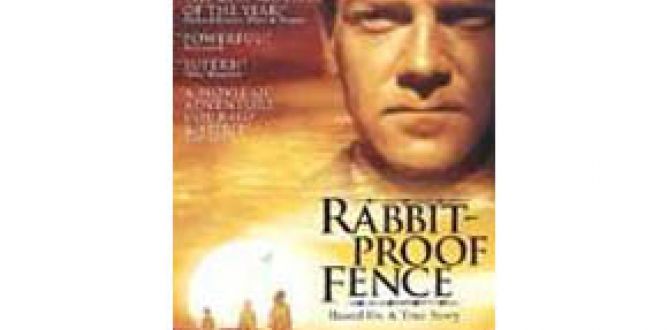Rabbit-Proof Fence Parent Guide
Parent Movie Review
It’s always refreshing to see a top row director take on a project of real value. Such is the case of Phillip Noyce and Rabbit-Proof Fence. Having helmed prominent titles like The Quiet American, Clear and Present Danger, and Patriot Games, this film provides a chance to share Noyce’s incredible ability with your family—even though it is still a very serious account.
As is often the case, this great film is closely based on a true story of remarkable courage and determination. Set in 1930’s Australia, the movie follows three children, Molly (Everlyn Sampi), Daisy (Tianna Sansbury), and Gracie (Laura Monaghan). The two sisters and their cousin are to be removed from their mother’s care by order of A.O. Neville (Kenneth Branagh), the government official in charge of the country’s Aboriginal people.
Mr. Neville’s mandate (which presumably reflects the feelings of the ruling majority at the time), centers on the girls’ parentage. Because they have an aboriginal mother and white father, the state feels they have a certain responsibility for these youngsters. Their solution is to remove the so-called “half-castes” from their lands and integrate them into white society. With luck, they will marry into the white race and thereby breed the “undesirable” native elements out of future generations.
Placed in the Moore River Native Settlement in Western Australia, the girls are now 1,500 miles from their home. Determined to make them as “white” as possible, staff members strip them of their former identity by forbidding them from speaking their own language, and train them for a life of servitude.
But the repressive environment is too much for the eldest Molly, who determines to escape. With the younger two following behind, they make their way across the rugged geography with the guidance of the incredibly long rabbit-proof fence. Erected as a rodent barrier, the girls know the other end of it runs past their home. Meanwhile, authorities are at their heels in an attempt to recapture the trio and give them what they consider to be a better life.
Using authentic native talent (the three children have no previous performance experience), and working with a script closely based on the book authored by Molly’s daughter, Doris Pilkington, director Noyce creates a compelling expose of an Australian practice that continued until 1970. Especially unique is the director’s use of silence and natural sounds to support the strong visual images.
Known now as the “stolen generations,” Rabbit-proof Fence judiciously uses moments of tension and conflict to develop our empathy toward the young girls, adding only a hint of sexual innuendo, some appropriate violence, and no profanity. Older children and teens will appreciate the obvious points of discussion regarding racial prejudice and the notion of white supremacy, while celebrating the tenacity of the human spirit.
Running time: 94 minutes. Updated July 17, 2017
Rabbit-Proof Fence
Rating & Content Info
Why is Rabbit-Proof Fence rated PG? Rabbit-Proof Fence is rated PG by the MPAA
Overall: A-
When Australian law requires the removal of three aboriginal/white children from their mothers’ custody, the young girls determine to return to their home. In order to do so they must escape from the camp where they are being detained, and walk 1200 miles along theRabbit-proof Fence. This film chronicles the true story of their heroic venture.
Violence: B
A family hunts and kills a lizard. A rotting animal carcass is shown, and part of it is eaten. Families live in constant fear of their children being taken away. Children are verbally threatened. Parents and children mourn when they are separated. Grieving woman hits her head with a rock. Children are placed in cages while being transported. Children are kept at camp against their will; escapees are tracked down, returned, spanked, and locked in an isolation shed. Coercion is used to secure obedience. Children sustain minor injuries, and suffer from heat exhaustion, starvation and thirst. Children steal food and clothing. Children are in peril of being caught by authorities. Man caring gun tries to stare down a woman caring a spear.
Sexual Content: B+
Fathers who have abandoned their children are mentioned. Woman remarks, “If Mr. Neville wants a half caste kid, he can make his own.” A sexual intention is implied when a man enters a woman’s room and removes his trousers (no nudity is shown). A topless aboriginal woman is briefly seen.
Language: A
Mild name-calling only.
Alcohol / Drug Use: A
A man smokes a cigarette.
Miscellaneous Concerns:
Prejudice and disrespect are portrayed toward aboriginal and half-caste races.
Page last updated July 17, 2017
Rabbit-Proof Fence Parents' Guide
The Australian government was trying to “protect” the mixed-races people “from themselves.” Would it have been right to deny these half-white children a place in the white world? Was it fair to remove these half-aboriginal children from their homes and family? If you were Mr. Neville, how would you have handled this problem?
European settlers displaced indigenous populations in every country they colonized. Could they have done anything differently? What should they do now?
Home Video
Related home video titles:
For more information about the Stolen Generations, check out www.alphalink.com.au/~rez/Journey/qna.htm
Video alternatives…
The miniseries Roots follows the adversity of another race that was removed from their families and native culture. A young boy is forced to survive in the wilderness while trying to make his way back to his family in the movie Far From Home: The Adventures of Yellow Dog.

